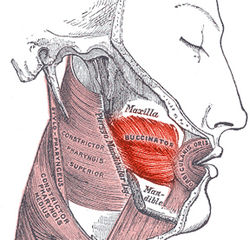Our website is made possible by displaying online advertisements to our visitors.
Please consider supporting us by disabling your ad blocker.
Buccinator muscle
| Buccinator muscle | |
|---|---|
 Buccinator outlined in red. | |
| Details | |
| Origin | From the alveolar processes of maxilla and mandible, buccinator crest and temporomandibular joint |
| Insertion | In the fibers of the orbicularis oris |
| Artery | Buccal artery |
| Nerve | Buccal branch of the facial nerve (VII cranial nerve) |
| Actions | The buccinator compresses the cheeks against the teeth and is used in acts such as blowing. It is an assistant muscle of mastication (chewing) and in neonates it is used to suckle. |
| Identifiers | |
| Latin | musculus buccinator[1] |
| TA98 | A04.1.03.036 |
| TA2 | 2086 |
| FMA | 46834 |
| Anatomical terms of muscle | |
The buccinator (/ˈbʌksɪneɪtər/[2][3]) is a thin quadrilateral muscle occupying the interval between the maxilla and the mandible at the side of the face. It forms the anterior part of the cheek or the lateral wall of the oral cavity.[4]
- ^ TA A04.1.03.036
- ^ OED 2nd edition, 1989.
- ^ Entry "buccinator" in Merriam-Webster Online Dictionary.
- ^ Illustrated Anatomy of the Head and Neck, Fehrenbach and Herring, Elsevier, 2012, page 91
Previous Page Next Page


